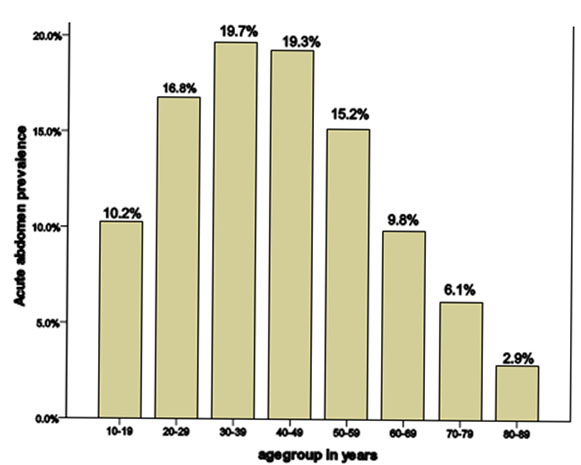 |
Clinical Studies
Causes of surgical acute abdomen in adults at St. Francis Hospital: A semi-urban hospital at Kilombero, Tanzania
1 MD, MMED Surgery, Lecturer, Department of Surgery, Faculty of Medicine, St. Francis University College of Health and Allied Sciences, Ifakara, Tanzania
2 MD, MMED Surgery, Head of Department, Department of Surgery, St. Francis Referral Hospital, Ifakara, Tanzania
3 MD, MMED Surgery, Department of Surgery, St. Francis Referral Hospital, Ifakara, Tanzania
4 Professor, Head of Department, Department of Physiology and Biochemistry, St. Francis University College of Health and Allied Sciences, Ifakara, Tanzania
Address correspondence to:
Theresia Andrew Karuhanga
P.O. BOX 175, Ifakara,
Tanzania
Message to Corresponding Author
Article ID: 100012G01TK2020
Access full text article on other devices

Access PDF of article on other devices

How to cite this article
Karuhanga TA, Tekie F, Mayoka RM, Balthazary ST. Causes of surgical acute abdomen in adults at St. Francis Hospital: A semi-urban hospital at Kilombero, Tanzania. Edorium J Gastroenterol 2020;7:100012G01TK2020.ABSTRACT
Aims: Acute abdomen (AA) is a non-traumatic abdominal pain contributing approximately 1% of total admission, commonly treated surgically, causing common surgical emergency with significant challenges to the surgeons. There is scanty study in Tanzania hence a need to conduct it at St. Francis Referral Hospital (SFRH).
Methods: A retrospective cross-sectional study was conducted using medical records at St. Francis Referral Hospital (SFRH) from October 2017 to October 1, 2019. The data were analyzed by using SPSS version 20.0 statistical package.
Results: Out of 284 patients, males were 185 (65.14%) and females were 99 (34.86%) with M:F of 1.9:1. The age ranged from 13 to 85, and the most prominent age group was 30–39 (19.7%). Abdominal pain was the major complain (100%). The bowel obstruction due to sigmoid volvulus was the common cause of AA 25% (71). Of all patients, 121 (42.6%) had long duration of illness (above 72 hours). Out of the surgically treated patients, 32 (14.03%) developed postoperative complications other than deaths. The commonest complication was wound infection (5.63%). The overall mortality rate was 12.68% (36).
Conclusion: The study has shown that acute abdomen commonly occurred in the third and fourth decades of life. The study has also described that AA at SFRH is mostly caused by large bowel obstruction due to sigmoid volvulus and peritonitis due to perforated peptic ulcer disease (PPUD). There is high mortality rate (12.68%) which may be contributed by delayed management due to long duration of illness.
Keywords: Acute abdomen, Significant challenges, Surgical emergency
INTRODUCTION
Acute abdomen (AA) may be defined as non-traumatic abdominal pain which develops within five to seven days [1]. Acute abdomen contributes about 5–10% of all Emergency Department (ED) visits worldwide [2]. Approximately 1% of the admission is due to acute abdomen, it is also one of the leading causes of hospital admissions in the United States [3]. Abdominal conditions contribute the significant challenges to both experienced hand as well as young surgeons, especially in poorly resourced countries caused by scarcity of diagnostic facilities [4]. In experienced hands bedside diagnosis is the cornerstone to the plan of management to prevent unnecessary addition delay in decision making [2],[4],[5]. The associated symptoms and clinical signs may give the evidences of underlying cause of primary illness [2]. The causes of acute abdomen may vary from one area to the other. The dynamic bowel obstruction and acute appendicitis are reported to be the leading causes of emergence acute abdomen in surgery [6],[7]. We realized that no study of the kind had been done in this hospital to document the causes of surgical acute abdomen in the adult patients providing the need to conduct this study at this center. It is hoped that such a study is going to highlight local causes of acute abdominal emergencies at St. Francis Referral Hospital (SFRH) which may be representative image of the hospitals of the same level in Tanzania.
METHODS
Study area
St. Francis Referral Hospital is located in Ifakara, a semi-urban area found in Kilombero District, Morogoro Region in the southwestern part of Tanzania which is about 417 km from Ifakara to Dar es Salaam where there is a National Referral Hospital. The hospital has a capacity of 400 beds and serves as a referral center for tertiary specialized cares for a catchment population of approximately 1.5 million people from neighboring districts of Ulanga, Mikumi, Kilosa, and Kilombero. It is also a teaching hospital for medical students of St. Francis University College of Health and Allied Sciences (SFUCHAS).
Study design
The study was a descriptive retrospective study of all patients with non-traumatic acute abdomen admitted to the surgical ward in St. Francis hospital. The source of information was obtained from the medical records and operating theatre register from October 1, 2017 to October 31, 2019. The data collection period was from December 1 to 21, 2019.
The study groups (N-284) were adult patients involving males and females. Most of the patients with clinical presentations and suspected to have acute abdomen were subjected to clinical investigations, to routine laboratory investigations imagining studies needed as per the clinical evaluations and availability of imaging studies concern. Patients with medical and gynecology acute abdomen as well as acute abdominal due to trauma were excluded from the study. Data were collected from the medical records and registers and analyzed by calculating the frequency of the causes of acute abdomen.
Data collection techniques and measurements
The data were collected by reviewing the registration books using a structured checklist which was developed in the English language to collect important recorded patient’s demographics and clinical features, management given, and the eventual outcome were recorded. For data collection, two clinical nurses who were not part of the St. Francis Hospital were recruited by Principal Investigator. The Principal Investigator oversaw the daily activities of data collectors. Patients who were admitted to surgical wards with the diagnosis of acute abdomen were initially identified from admission logbooks of surgical wards and operating theatre logbook for those who underwent operation. Addition information was obtained from hospital files by the use of hospital card numbers. The study involved three types of patients: patients whose AA was managed conservatively, patients who underwent an operation for AA, and patients who died either before or after operation after clinical confirmation (with/without diagnostic imaging). Patients with incomplete records (e.g., significant information like age, gender, name causes, and management outcome variables) were excluded from the study. Data were summarized in form of proportions and frequent tables. P-values were computed for categorical variables using Chi-square (χ2) test. The outcome of management was considered to be favorable if the patients did not develop either of postoperative complication or death after the management. Among the unfavorable outcomes included death, wound sepsis, enterocutaneous fistulae, and anastomotic leakage.
Ethical consideration
Ethical approval was obtained from SFRH and SFUCHAS Internal Ethical Committees before the commencement of the study.
RESULTS
Demographic characteristics
During the study period 1297 patients were admitted in surgical wards. Non-traumatic acute abdomen was the second cause of admission which comprised of 21.9% (284) of the total of surgical admission (who were eligible according to inclusion criteria) following trauma patients which comprised of 41.9% (535) and other surgical conditions were 36.85% (478). The males were 65.1% (185) while the females were 34.86% (99) making male to female ratio of 1.9:1. Majority of the patients (53.5%) were from rural areas while 46.5% patients were from urban regions. Age ranged from 13 to 85 years, and the most prominent age group was 30–39 years (19.7%) as shown in Figure 1, the mean age of the patients was 39 years and standard deviation was 17.49.
Clinical presentation and causes of acute abdomen at SFRH Ifakara
The abdominal pain was the most common clinical complain 284 (100%), followed by vomiting 206 (72.54%), abdominal distension 210 (74%), and constipation 205 (72.2%). Majority of the patients presented beyond 72 hours were 121 (42.6%), as it is shown in Table 1.
Causes of acute abdomen
The major cause of acute abdomen in this population was intestinal obstruction due to sigmoid volvulus 25% (71). Other causes were PPUD 23.9% (68), intestinal obstruction (IO) due to fecal impaction (7.04%) adhesion (5%), obstructed hernia, colonic tumor (2.8%), other causes were pelvic abscess (1.27%), cholecystitis (1.7%), pancreatitis (0.2%), and others (which involved 2 pyelonephritis, 1 misdiagnosed twisted ovarian cyst, 1 mesenteric ischemia, and 1 ureteric stone) making 1.76% of the patients (for details see Table 2).
Management and outcome in patients with surgical acute abdomen
During the study period, a total of 228 (80.3%) patients were operated, of which 72.4% (165) underwent laparotomy, appendicectomy 50 (21.93%), and herniorrhaphy 13 (5.7%). However, 56 (19.71%) patients were managed conservatively. Out of 284 patients, 248 (87.3%) were discharged alive while 36 (12.68%) patients died. Out of postoperative survivors, 32 (11.27%) patients developed postoperative complications of which 16 (5.63%) got wound infection, anastomotic leakage 7 (2.5%), enterocutaneous fistulae 5 (1.76%), and abdomen/wound dehiscence altogether accounted 1.41% (4) of overall complications. On the other side the high mortality rate was among the patients with peritonitis of which out of 36 patients who died, 18 (6.34%) had peritonitis due to PPUD. According to the multivariate logistic regression analysis, peritonitis (OR = 1.4, 95% CI (1.0–4.4), p = 0.021) and intestinal obstruction (OR = 3.0, 95% CI (1.9–8.5), p = 0.017) were the main predictors of mortality.
DISCUSSION
Acute abdomen remains one of the commonest surgical emergencies and causing surgeon’s challenge regardless of the advancement of modern diagnosis and management techniques such as computed tomography (CT) scan and magnetic resonance image (MRI). In surgery, patients with acute abdomen may be simply diagnosed clinically by experienced clinicians through details of relevant information from the patient [4], and experienced hands may easily detect the abnormal physical examination findings [1],[4],[8].
In this study, acute abdomen constituted 21.9% of the total surgical admissions. This correlated with other studies reported in the literature [1],[9],[10]. Other studies done in Africa reported higher values [11],[12],[13]. The possible cause of this variation could be due to differences in selection criteria used in these specific studies. In our study the male to female ratio was 1.9:1. Most of the patients were in the third and fourth decades of life as shown in Figure 1. This is in contrast to what was reported by Zinabu et al. in Ethiopia who reported the second and third decades of life to be more affected by acute abdomen [14].
In our study, abdominal pain was the commonest clinical complain (100%) followed by abdominal distension (63.38%), vomiting (62.33%), and constipation (62.0%), which is in agreement with what was reported previously in other literatures [11],[12],[13]. The study detected the bowel obstruction due to sigmoid volvulus as the commonest causes of acute abdomen at this hospital (25.0%) followed by PPUD (23.94%). Perforated peptic ulcer disease seems to be significantly high at this hospital. The possible cause of high perforation rate of PPUD could be attributed to increased use of non-steroidal anti-inflammatory drugs (NSAIDs) which are normally obtained locally from the private pharmacies and medical shops. However, this needs further investigational study to determine the possible risk factors contributing to high prevalence of PPUD in this population. Ileal and appendicular perforations were other causes of AA found in this study, 7.39% being lower to what was reported by Obonna et al., whose study found appendicular and typhoid peritonitis caused by peritonitis to be 32.4% and 16.8%, respectively [4]. Zinabu et al. in Ethiopia reported the appendicular perforation to be 13.0% while PPUD and typhoid ileal perforation was 10.2% [14]. Bowel perforation is a serious clinical condition and remains a significant surgical problem in low and middle income countries (LMIC) as it is associated with high morbidity and mortality [2]. Adhesion (4.93%), obstructed hernia (4.58%), and colonic tumors (2.82%) are less common causes of acute abdomen at this hospital. The study contrast to what was reported by Obonna whose study mentioned strangulated hernia to be 51.2% while postoperative adhesion was 14.6% [4].
The bowel obstruction and peritonitis were leading causes of laparotomy which was observed in 165 (58.1%) patients. In this study, wound infection was the common postoperative complication which contributed 5.63% (16) among 32 patients who developed complications. This correlates with what was reported in Ethiopia whereby wound infection was found to be 53.2% [11]. The study also correlates to what was reported in different studies done in Africa [1],[9],[10],[11]. Taking into mind that most of the patients had arrived at the hospital beyond 72 hours (42.6%), pre-hospital management delay could be the major contributing factor of postoperative complications. Taking into consideration that majority of the patients had mechanical bowel obstruction and peritonitis which are prone to have septicemia and toxemia as well, but also to have contaminated surgical wound at the moment of operation due to peritoneal spillage of fecal contents in patients with perforated visceral peritonitis or during resection diseased bowel. All these factors are major risk factors for postoperative wound infection.
In this study, the overall mortality rate was 12.68% which was higher than that was reported by Aijaz (9.55%) [2]. The studies of Mekonnen and Adam Ahmed et al. reported 6.4% and 6.0% overall mortality rates, respectively[5],[11], and Obonna in Nigeria reported 1.1% mortality rate [4]. The possible contributing factor for high mortality in this study may be contributed by delayed management.
CONCLUSION
In conclusion, our study has shown that the commonest cause of acute abdomen at SFRH was bowel obstruction due to sigmoid volvulus followed by peritonitis while the leading cause of peritonitis was found to be peptic ulcer perforation. Pre-hospital delays seem to be a contributing factor for the poor management outcome. The reason may be attributed to the lack of finance since most of the patients were coming from rural areas with no health insurance and also due to poor infrastructure and transport problems from the remote areas. These problems should be addressed to reduce postoperative morbidity which leads to prolonged length of hospitalization (LOH) as well as reduction of mortality rate.
REFERENCE
1.
Cervellin G, Mora R, Ticinesi A, et al. Epidemiology and outcomes of acute abdominal pain in a large urban emergency department: Retrospective analysis of 5,340 cases. Ann Transl Med 2016;4(19):362. [CrossRef]
[Pubmed]

2.
3.
Trninić Z, Spahalić M, Galić G, et al. Pain intensity scales comparison in patient with abdominal pain. Psychiatr Danub 2017;29(Suppl 4):845–50.
[Pubmed]

4.
5.
6.
7.
Gans SL, Pols MA, Stoker J, Boermeester MA, Expert steering group. Guideline for the diagnostic pathway in patients with acute abdominal pain. Dig Surg 2015;32(1):23–31. [CrossRef]
[Pubmed]

8.
Macaluso CR, McNamara RM. Evaluation and management of acute abdominal pain in the emergency department. Int J Gen Med 2012;5:789–97. [CrossRef]
[Pubmed]

9.
10.
11.
Hagos M. Acute abdomen in adults: A two year experience in Mekelle, Ethiopia. Ethiop Med J 2015;53(1):19–24.
[Pubmed]

12.
Caporale N, Morselli-Labate AM, Nardi E, Cogliandro R, Cavazza M, Stanghellini V. Acute abdominal pain in the emergency department of a university hospital in Italy. United European Gastroentrol J 2016;4(2):297–304. [CrossRef]
[Pubmed]

13.
Agboola JO, Olatoke SA, Rahman GA. Pattern and presentation of acute abdomen in a Nigerian teaching hospital. Niger Med J 2014;55(3):266–70. [CrossRef]
[Pubmed]

14.
Ayenew Z, Gizaw AT, Workneh D, Fentahun N. Outcome of non-traumatic surgical acute abdomen in Nekemte Referral Hospital Southwest Ethiopia: A retrospective cross-sectional study. Surgery Curr Res 2016;7(1):282. [CrossRef]

SUPPORTING INFORMATION
Acknowledgement
We would like to thank the Principal of St. Francis University College of Health and Allied Science (SFUCHAS) and the Director of St. Francis Referral Hospital for support rendered during our study period.
Author ContributionsTheresia Andrew Karuhanga - Conception of the work, Design of the work, Acquisition of data, Analysis of data, Revising the work critically for important intellectual content, Final approval of the version to be published, Agree to be accountable for all aspects of the work in ensuring that questions related to the accuracy or integrity of any part of the work are appropriately investigated and resolved.
Fassil Tekie - Conception of the work, Design of the work, Acquisition of data, Drafting the work, Revising the work critically for important intellectual content, Final approval of the version to be published, Agree to be accountable for all aspects of the work in ensuring that questions related to the accuracy or integrity of any part of the work are appropriately investigated and resolved.
Rashid Mrisho Mayoka - Conception of the work, Design of the work, Revising the work critically for important intellectual content, Final approval of the version to be published, Agree to be accountable for all aspects of the work in ensuring that questions related to the accuracy or integrity of any part of the work are appropriately investigated and resolved.
Sakurani Theobald Balthazary - Analysis of data, Drafting the work, Revising the work critically for important intellectual content, Final approval of the version to be published, Agree to be accountable for all aspects of the work in ensuring that questions related to the accuracy or integrity of any part of the work are appropriately investigated and resolved.
Guarantor of SubmissionThe corresponding author is the guarantor of submission
Source of SupportNone
Consent StatementWritten informed consent was obtained from the patient for publication of this article.
Data AvailabilityAll relevant data are within the paper and its Supporting Information files.
Conflict of InterestAuthors declare no conflict of interest.
Copyright© 2020 Theresia Andrew Karuhanga et al. This article is distributed under the terms of Creative Commons Attribution License which permits unrestricted use, distribution and reproduction in any medium provided the original author(s) and original publisher are properly credited. Please see the copyright policy on the journal website for more information.







